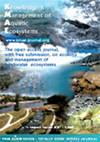水生海龟的栖息地重叠和身体状况:入侵物种和本地物种之间是否存在加性效应?
IF 1.7
3区 环境科学与生态学
Q3 FISHERIES
引用次数: 4
摘要
长尾爬行动物是世界上分布最广的入侵爬行动物之一。一般来说,根据在受控条件下进行的实验,假设该物种对本地水生海龟有负面影响。在这里,我们分析了伊比利亚半岛东北部自然种群中捕获的三种海龟(两种本地海龟和一种外来海龟)的7年时间序列(2013-2019年)数据。我们评估了:(1)种间空间重叠和(2)原生龟的比例质量指数(SMI)与scripta丰度的相关性,包括种间的相互作用效应。分析结果表明,斑蝽与圆斑蝽的空间重叠度较低,而与麻风毛螨的空间重叠度较高。总体而言,scripta的丰度与本地物种的SMI差异不显著,但雌性轮轴棘猴的SMI呈负相关。分析还表明,即使在本地物种之间存在负影响,scripta的丰度对其他海龟的SMI没有加性影响。这些发现表明,scripta对其他海龟的影响可能是密度依赖的。本文章由计算机程序翻译,如有差异,请以英文原文为准。
Habitat overlap and body condition in aquatic turtles: are there additive effects between invasive and native species?
Trachemys scripta (Reptilia, Emydidae) is among the most widespread invasive reptiles in the world. In general, it is assumed that this species has negative effects on native aquatic turtles based on experiments conducted under controlled conditions. Here, we analysed a 7‒year time series (2013‒2019) of data from captures of three species of turtles (two natives and one alien) from natural populations in the northeastern Iberian Peninsula. We evaluated (i) the interspecific spatial overlap and (ii) the correlation between the scaled mass index (SMI) of the native turtles and the abundance of T. scripta, including an interaction effect between the species. The analyses revealed that T. scripta has relatively low spatial overlap with Emys orbicularis but high overlap with Mauremys leprosa. Overall, the abundance of T. scripta was not associated with significant variations in the SMI of the native species, although for the female E. orbicularis, we detected a negative trend. The analyses also indicated that the abundance of T. scripta does not have an additive effect on the SMI of other turtles, even if there is a negative effect between native species. These findings suggested that the impact of T. scripta on other turtles could be density-dependent.
求助全文
通过发布文献求助,成功后即可免费获取论文全文。
去求助
来源期刊

Knowledge and Management of Aquatic Ecosystems
环境科学-海洋与淡水生物学
CiteScore
3.70
自引率
5.60%
发文量
22
审稿时长
>12 weeks
期刊介绍:
Knowledge and Management of Aquatic Ecosystems (KMAE-Bulletin Français de la Pêche et de la Pisciculture since 1928) serves as a foundation for scientific advice across the broad spectrum of management and conservation issues related to freshwater ecosystems.
The journal publishes articles, short communications, reviews, comments and replies that contribute to a scientific understanding of freshwater ecosystems and the impact of human activities upon these systems. Its scope includes economic, social, and public administration studies, in so far as they are directly concerned with the management of freshwater ecosystems (e.g. European Water Framework Directive, USA Clean Water Act, Canadian Water Quality Guidelines, …) and prove of general interest to freshwater specialists. Papers on insular freshwater ecosystems and on transitional waters are welcome. KMAE is not a preferred journal for taxonomical, physiological, biological, toxicological studies, unless a clear link to ecological aspects can be established. Articles with a very descriptive content can be accepted if they are part of a broader ecological context.
 求助内容:
求助内容: 应助结果提醒方式:
应助结果提醒方式:


